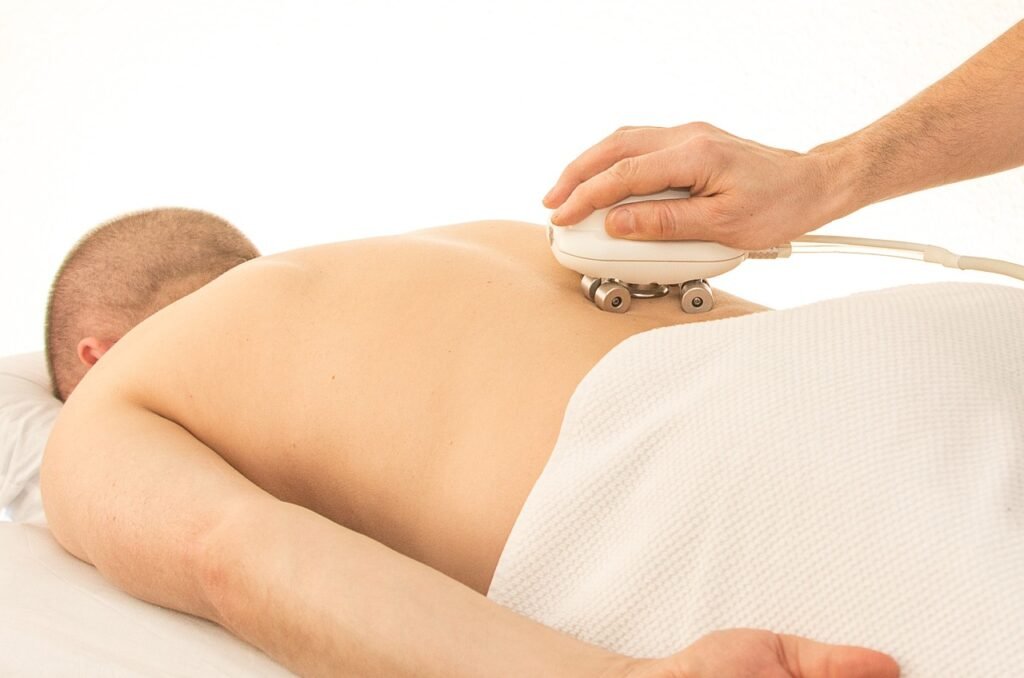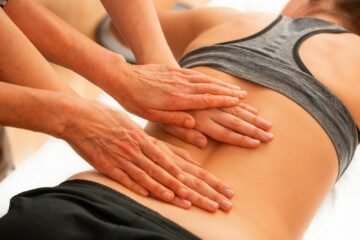Back pain is one of the most common reasons people visit a doctor. It can affect various parts of the back, from the upper to the lower regions, and understanding the specific location of the pain can help in diagnosing the cause. The back is a complex structure made up of muscles, bones, and nerves, and pain can occur for many reasons.
In this article, we will focus on different back pain locations, such as lower left back pain, lower right back pain, and pain between the shoulder blades. Understanding where your pain is located can provide clues to the underlying issue and guide treatment.
1. Lower Back Pain
Lower back pain is a very common condition that affects people of all ages. The lower back supports much of your body’s weight and is involved in a wide range of movements, making it susceptible to injury.
1.1 Lower Left Back Pain
Lower left back pain often results from muscle strain, poor posture, or conditions like a herniated disc. It can also be linked to issues with internal organs, such as the kidneys or intestines. If the pain is persistent or sharp, it’s crucial to see a doctor for further evaluation.
Some common causes of lower left back pain include:
- Muscle Strain: Overuse or sudden movements can strain the muscles in the lower left back.
- Herniated Disc: A disc in the spine may slip out of place, causing pain that radiates to the left side.
- Kidney Issues: Infections or kidney stones can lead to pain in the lower left back, often accompanied by other symptoms like difficulty urinating.
1.2 Lower Right Back Pain
Like the left side, lower right back pain can result from muscle strain, poor posture, or kidney problems. If the pain is sharp or severe, it’s important to seek medical advice to rule out more serious conditions.
Some causes of lower right back pain include:
- Sciatica: This occurs when the sciatic nerve is compressed, causing sharp pain down the lower right side.
- Kidney Stones: These can cause sharp pain in the lower right back, often accompanied by nausea or changes in urination.
- Appendicitis: Although appendicitis pain typically starts in the abdomen, it can sometimes radiate to the lower right back.
2. Pain in the Middle Lower Back
Middle lower back pain is often related to the spine and surrounding muscles. It may result from poor posture, overuse, or conditions affecting the spine, such as scoliosis or herniated discs. In some cases, this pain may also be linked to issues with the internal organs, such as the kidneys or pancreas.
Common causes of middle lower back pain include:
- Muscle Strain: Overusing or injuring the muscles in the lower back can cause pain in the middle region.
- Spinal Conditions: Conditions like scoliosis or degenerative disc disease can lead to persistent middle lower back pain.
- Kidney Infections: Pain from kidney infections can radiate to the middle lower back, often accompanied by fever or other symptoms.
3. Right and Left Side Lower Back Pain

Lower back pain on the sides can be particularly uncomfortable, and its causes may vary depending on which side is affected.
3.1 Right Side Lower Back Pain
Right side lower back pain can be caused by injuries, such as muscle strain, or more serious conditions like herniated discs or kidney infections. Sharp or persistent pain may require further evaluation by a doctor.
Common causes include:
- Kidney Problems: Infections or stones in the right kidney can cause pain in the lower right side.
- Muscle Strain: Overworking or straining the muscles on the right side of the back can lead to pain.
- Sciatica: When the sciatic nerve is irritated, pain may radiate down the right side of the back and leg.
3.2 Left Side Lower Back Pain
Left side lower back pain is often linked to similar issues as the right side, including muscle strain, herniated discs, or kidney issues. Internal organs, like the spleen or intestines, may also cause pain in this area.
Some causes include:
- Herniated Disc: A slipped disc can compress nearby nerves, causing pain on the left side of the lower back.
- Kidney Stones or Infection: Kidney problems can cause pain on the left side, often accompanied by fever, nausea, or difficulty urinating.
- Poor Posture: Bad posture can strain the muscles on one side of the back, leading to persistent pain.
Table: Common Causes of Lower Back Pain by Location
| Location | Possible Causes |
|---|---|
| Lower Left Back Pain | Muscle strain, herniated disc, kidney infection, poor posture |
| Lower Right Back Pain | Sciatica, kidney stones, muscle strain, appendicitis |
| Middle Lower Back Pain | Muscle strain, spinal conditions, kidney infection |
| Right Side Lower Back Pain | Kidney issues, muscle strain, sciatica, herniated disc |
| Left Side Lower Back Pain | Herniated disc, kidney stones, poor posture, muscle strain |
4. Upper Back Pain Between Shoulder Blades
Pain between the shoulder blades is less common than lower back pain but can still cause significant discomfort. This type of pain can be related to muscle strain, poor posture, or more serious conditions affecting the spine, heart, or lungs.
4.1 Common Causes in Females
For females, upper back pain between the shoulder blades can also be linked to specific issues like hormonal changes, stress, or pregnancy.
Some causes include:
- Poor Posture: Sitting hunched over for long periods can strain the muscles between the shoulder blades.
- Muscle Strain: Overuse or improper lifting techniques can lead to muscle strain in the upper back.
- Heart Conditions: In rare cases, upper back pain between the shoulder blades can be a sign of heart problems, particularly in women.
Recent Post: What Back Pain Causes: Understanding the Reasons Behind Back Discomfort
5. Chronic Pain in Different Back Locations
Chronic back pain is pain that lasts for 12 weeks or longer, and it can occur in any part of the back, from the lower to the upper regions. Chronic back pain may be caused by underlying conditions that affect the spine or the muscles. If the pain persists, it’s crucial to seek medical attention to determine the underlying cause and create a treatment plan.
5.1 Chronic Lower Left Back Pain
Chronic pain in the lower left back may be due to long-term conditions such as:
- Degenerative Disc Disease: As we age, the discs in our spine can wear out, leading to chronic lower left back pain.
- Spinal Stenosis: This condition occurs when the spaces in the spine narrow, putting pressure on the spinal cord and nerves, which can cause chronic pain.
- Osteoarthritis: The cartilage that cushions the joints may break down over time, causing pain in the lower back, including the left side.
5.2 Chronic Lower Right Back Pain
Chronic pain in the lower right back can be due to similar causes, such as degenerative conditions, injuries, or repetitive strain on the muscles.
Some common causes of chronic lower right back pain include:
- Herniated Disc: A disc that has slipped or ruptured can cause long-term irritation of nearby nerves, leading to chronic pain.
- Sacroiliac Joint Dysfunction: This joint connects the pelvis to the spine, and if it becomes inflamed or moves abnormally, it can lead to chronic pain in the lower right back.
5.3 Chronic Upper Back Pain
Chronic pain between the shoulder blades or in the upper back is often caused by muscle strain or issues with the spine.
Common causes of chronic upper back pain include:
- Postural Issues: Poor posture, such as hunching over a desk for long periods, can cause chronic upper back pain.
- Kyphosis: This condition involves an abnormal curvature of the upper spine, leading to chronic discomfort.
- Myofascial Pain Syndrome: This is a chronic condition that causes pain in the muscles of the upper back, often due to overuse or injury.
6. Treatment Options for Back Pain by Location
Treatment for back pain depends on the location and cause of the pain. For most types of back pain, a combination of rest, physical therapy, and medication can provide relief. However, more severe cases may require surgery or other advanced treatments.
6.1 Treatment for Lower Left and Right Back Pain
- Physical Therapy: Strengthening the muscles in the lower back can help alleviate pain and prevent future injuries.
- Anti-inflammatory Medications: Over-the-counter or prescription medications can help reduce inflammation and provide relief.
- Heat and Ice Therapy: Alternating between heat and ice packs can reduce swelling and improve blood flow to the affected area.
6.2 Treatment for Middle and Upper Back Pain
- Posture Correction: Improving posture can significantly reduce pain between the shoulder blades or in the upper back.
- Chiropractic Care: Chiropractic adjustments can help realign the spine and alleviate upper and middle back pain.
- Massage Therapy: Massaging the muscles in the upper back can relieve tension and improve circulation.
6.3 Surgical Options for Chronic Back Pain
For chronic pain caused by spinal conditions, surgery may be necessary. Some common surgical treatments include:
- Spinal Fusion: This procedure involves fusing two or more vertebrae together to prevent movement and alleviate pain.
- Laminectomy: A laminectomy involves removing part of the vertebra to relieve pressure on the spinal cord or nerves.
Table: Common Treatments for Back Pain by Location
| Back Pain Location | Treatment Options |
|---|---|
| Lower Left Back Pain | Physical therapy, anti-inflammatory meds, heat/ice therapy |
| Lower Right Back Pain | Chiropractic care, posture correction, muscle strengthening |
| Middle Lower Back Pain | Massage therapy, chiropractic adjustments, posture support |
| Upper Back Pain | Posture correction, chiropractic care, massage therapy |
| Chronic Back Pain | Physical therapy, medications, possible surgical intervention |
7. Preventing Back Pain in Different Areas
While some causes of back pain are unavoidable, there are steps you can take to reduce your risk of developing pain in different areas of the back. Proper posture, regular exercise, and maintaining a healthy weight can help keep your back in good condition.
7.1 Preventing Lower Back Pain
- Lift Properly: When lifting heavy objects, always bend at the knees and keep your back straight to avoid straining your lower back.
- Strengthen Core Muscles: Strengthening the muscles in your abdomen and lower back can help support your spine and reduce the risk of injury.
- Maintain a Healthy Weight: Excess weight can put extra strain on your lower back, so maintaining a healthy weight can help prevent pain.
7.2 Preventing Upper Back Pain
- Improve Posture: Sitting and standing with proper posture can prevent muscle strain and discomfort in the upper back.
- Take Breaks: If you sit for long periods, make sure to take breaks and stretch your upper back and shoulders.
- Strengthen Upper Back Muscles: Strengthening the muscles in your upper back can help support your spine and reduce pain.
Conclusion
Back pain can occur in various locations, from the lower left back to the upper back between the shoulder blades. Each location of back pain may have different causes, ranging from muscle strain and poor posture to more serious conditions like herniated discs or kidney problems. Understanding the location of your pain can help you and your healthcare provider determine the underlying cause and develop a treatment plan. If you’re experiencing persistent or severe back pain, it’s essential to seek medical advice.




